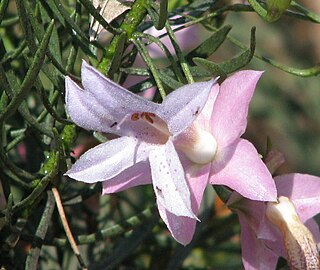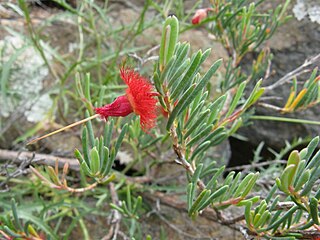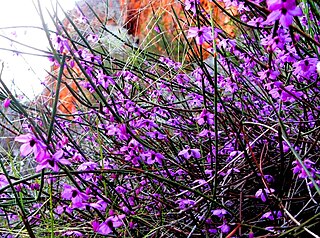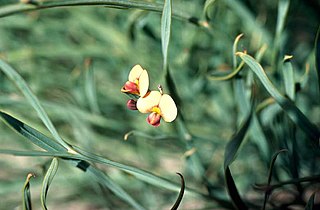
Eremophila oldfieldii, commonly known as pixie bush, is a flowering plant in the figwort family, Scrophulariaceae and is endemic to Western Australia. It is a shrub or small tree with rough bark, broad, flat or narrow fleshy leaves and red, orange or yellow flowers.

Eremophila abietina, also known as spotted poverty bush, is a plant in the figwort family, Scrophulariaceae and is endemic to a few arid areas of Western Australia. It is a stiff, upright, compact and very sticky shrub with distinctive, dark bluish-green leaves and pale coloured flowers spotted purple.

Melaleuca lateriflora, commonly known as gorada, is a plant in the myrtle family, Myrtaceae and is endemic to the south-west of Western Australia. It is usually an erect shrub with oval leaves and small clusters of white flowers mainly along the older branches.

Melaleuca macronychia is a shrub in the myrtle family Myrtaceae, endemic to the south-west of Western Australia. Its large, red flower spikes and long flowering period contribute to its popularity as a garden plant. There are two subspecies, distinguished mainly by the shape of the leaves.

Eucalyptus effusa, commonly known as rough-barked gimlet, is a species of mallee or small tree that is endemic to Western Australia. It has thin, rough bark on the base of the trunk, smooth bark above, linear to narrow lance-shaped adult leaves, flower buds arranged in groups of seven, white flowers and cup-shaped to conical fruit.

Verticordia mitchelliana, commonly known as rapier featherflower, is a flowering plant in the myrtle family, Myrtaceae and is endemic to the south-west of Western Australia. It is a shrub with bright red, rapier-like flowers in spring and early summer, which readily distinguish it from other species. It is commonly grown in private gardens and some forms have larger flowers than those usually found in the wild.

Grevillea commutata is a species of flowering plant in the family Proteaceae and is endemic to the west of Western Australia. It is a spreading, open to dense shrub with egg-shaped leaves with the narrower end towards the base, and white, cream-coloured, and pinkish-green flowers.

Caladenia flava subsp. flava, commonly known as the cowslip orchid, is a species of orchid endemic to the south-west of Western Australia. It is a relatively common orchid with a single, hairy leaf and up to three golden-yellow flowers which often have red markings.

Caladenia attingens subsp. gracillima, commonly known as the small mantis orchid, is a species of orchid endemic to the south-west of Western Australia. It is a relatively common orchid with a single erect, hairy leaf and one or two green, yellow and red flowers. It differs from subspecies attingens in having smaller flowers and a more easterly distribution.

Caladenia longicauda subsp. rigidula, commonly known as the rigid white spider orchid or island white spider orchid, is a plant in the orchid family Orchidaceae and is endemic to the south-west of Western Australia. It has a single hairy leaf and up to three large, mainly white flowers with relatively short lateral sepals and petals. It is similar to the reclining white spider orchid but that species has smaller, cream-coloured flowers.

Thryptomene australis, commonly known as hook-leaf thryptomene, is a species of flowering plant in the family Myrtaceae and is endemic to the south-west of Western Australia. It is an erect, bushy and spreading shrub with upward-pointing leaves with the tip curving outwards, and flowers with white petals arranged spike-like near the ends of the branchlets.
Eucalyptus alipes is a mallet that is endemic to the south-west of Western Australia. It has smooth grey to light brown or bronze bark, linear to narrow elliptic leaves, oval to spindle-shaped buds with a long, narrow operculum and conical fruits.
Eucalyptus distuberosa is a species of mallet that is endemic to the south-west of Western Australia. It has smooth dark grey to tan-coloured or creamy white bark, glossy dark green, lance-shaped adult leaves, flower buds in groups of seven, white flowers and cup-shaped to conical fruit.

Goodenia scapigera, commonly known as white goodenia, is a species of flowering plant in the family Goodeniaceae and is endemic to the south-west of Western Australia. It is an erect, perennial herb or shrub with linear to narrow egg-shaped leaves clustered near the ends of the stems, and thyrses of white flowers with purplish spots.
Hibbertia lepidocalyx is a species of flowering plant in the family Dilleniaceae and is endemic to Western Australia. It is a shrub with thick, linear, cylindrical leaves and yellow flowers with nine or ten stamens in a single group on one side of the two carpels.
Tetratheca harperi, also known as Jackson Tetratheca, is a species of flowering plant in the quandong family that is endemic to Australia.

Tetratheca aphylla, also known as the Bungalbin Tetratheca, is a species of flowering plant in the quandong family that is endemic to Australia.

Daviesia decurrens, commonly known as prickly bitter-pea, is a species of flowering plant in the family Fabaceae and is endemic to the south-west of Western Australia. It is spreading, erect, or low-lying shrub with scattered, sharply-pointed, narrow triangular phyllodes, and yellowish pink and velvety red flowers.

Daviesia implexa is a species of flowering plant in the family Fabaceae and is endemic to the south-west of Western Australia. It is a mound-shaped shrub with many tangled stems, scattered linear phyllodes and yellow or apricot-coloured, reddish-brown and yellowish-green flowers.

Daviesia sarissa is a species of flowering plant in the family Fabaceae and is endemic to inland areas of south-western Western Australia. It is a spreading or sprawling, glaucous shrub with scattered, long, rigid, cylindrical, sharply-pointed phyllodes, and orange-yellow and red flowers.
















